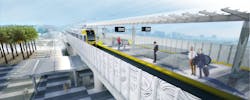Metro Crenshaw-LAX Line Project Update
The Los Angeles County Metropolitan Transportation Authority (Metro) Crenshaw/LAX Line will extend from the existing Metro Exposition Line at Crenshaw and Exposition Boulevards, serving L.A., Inglewood, El Segundo and portions of unincorporated Los Angeles County.
Charles Beauvois, Crenshaw/LAX project manager, said the project is extremely complex because there is underground tunnel boring, cut and cover, multiple bridges and goes through three different communities.
The overall project configuration consists of eight stations, three of those being underground, one an aerial structure and the remaining four stations are at grade. The project also includes six bridges, one being the aerial structure.
To perform the construction of the underground stations and commence tunneling between those stations, they first had to excavate the hole that needs to eventually hold the stations. They close Crenshaw, a major arterial, to excavate the first 10 feet, put in a bridge system over the top of the roadway and then open it back up so the public could continue to drive over the surface as they continued to excavate the last 60 feet and build their stations. Beauvois said, “We did that for those three major stations and we’ve started some of the construction of Expo for the station itself.” He added, “That area is being used as a launch area for the tunnel boring machine.”
The tunnel boring machine is drilling the hole for the trainways between the stations. As it’s doing that, it’s also building a shelf that will become the final tunnel. Beauvois said, “It’s a pretty amazing piece of equipment. It was launched a little over a month ago and that’s progressing fairly well.
“We’re hoping to get an average of 70 feet per day and we’ve gotten some increments that have been 90 feet per day, so we’re pretty optimistic about that in keeping us on track and on schedule.”
A lot of the bridges are also under construction. The La Brea bridge is fairly close to being complete and the Century Bridge, the second largest bridge where the station is going to be located is well under construction, as well.
Beauvois said he expects the bridge portion will be done in the next couple months and then they’ll start the station component of the construction process.
A Community Partner
The construction relations group is one of the more vital components of the project, said Beauvois. The impacts of construction have been of limited duration, as they had 30 days or 15 days of closures of Crenshaw completely. “Those were manageable bites, if you will, for the community,” he explained. “The areas that will have greater impact that we’re woking on at the moment are areas that we’re working at grade … we’ll have to work in the center of the roadway.”
Another program that is part of this process is the Business Interruption Fund, where Metro provides funding for businesses that are impacted by construction. If a business is no longer a business after construction, Beauvois said, “it sort of defeats the purpose of revitalizing.”
There is also a Business Solutions Center that accompanies that program. It helps businesses with a variety of things, such as learning how to improve their accounting system, or use the Internet. “The accounting part is important because in order to receive funding from the Business Interruption Fund, you need to prove that in past years, that you were able to make a certain amount of money,” explained Beauvois, “and that this year, because of construction, there’s a disparity that needs to be made up.
“Sometimes these small businesses aren’t as good with keeping track of those records, so that solution center is very helpful.”
The Business Interruption Fund is focused on small businesses, businesses with 26 employees or less.
While the most important part of construction is the construction, Beauvois stressed, “You are working in a community and you always have to keep that first and foremost in your mind with all of the planning and having a construction relations group that is proactively communicating with the community what is coming and what the impact will be and being very open about it.
“If they are surprised, they get very disappointed in the process,” he said. “The community accepts it when they know about it.”
The line will increase connectivity of the community with the rest of Los Angeles, providing access to schools and jobs. The community it will serve, Beauvois explained, has some of the highest ridership of transit and currently they have to rely on buses, for the most part. “With the train coming through, it’s going to be a real difference maker for this community.”
